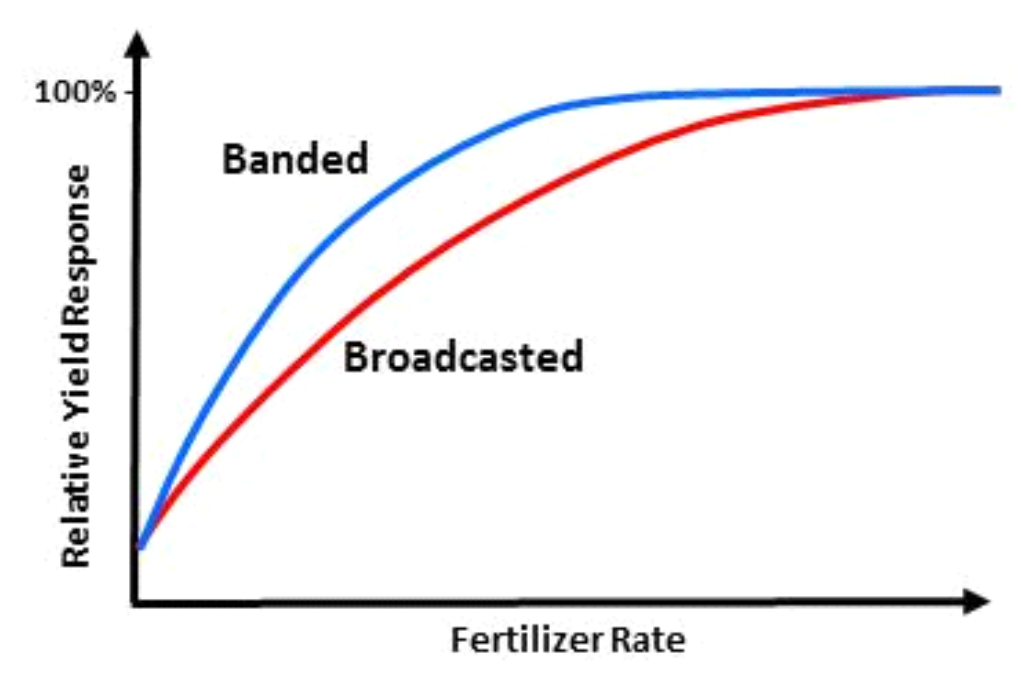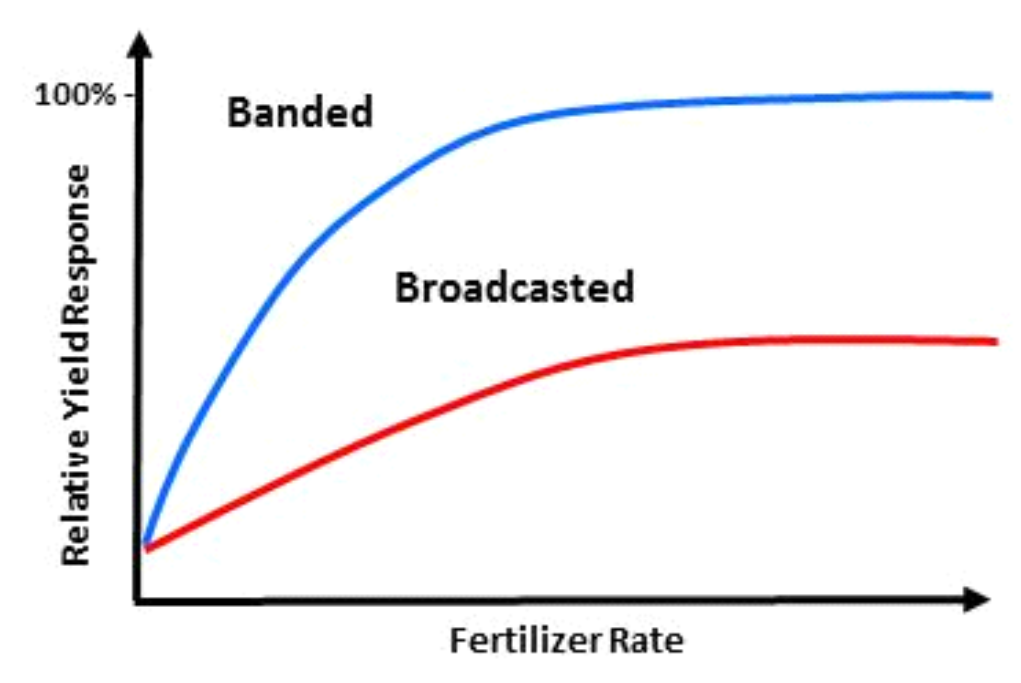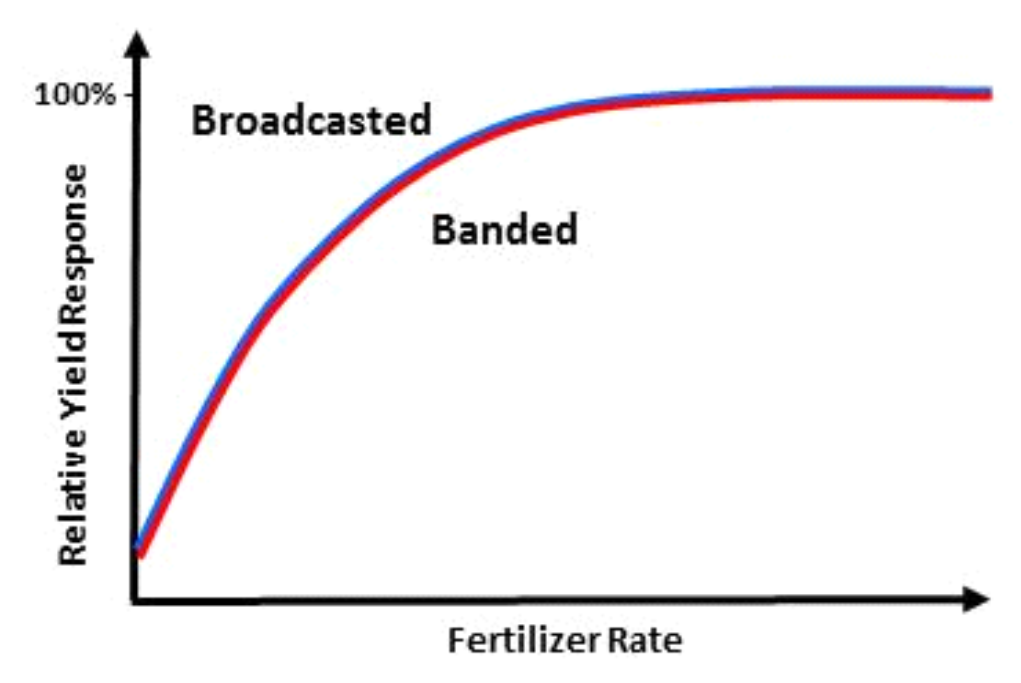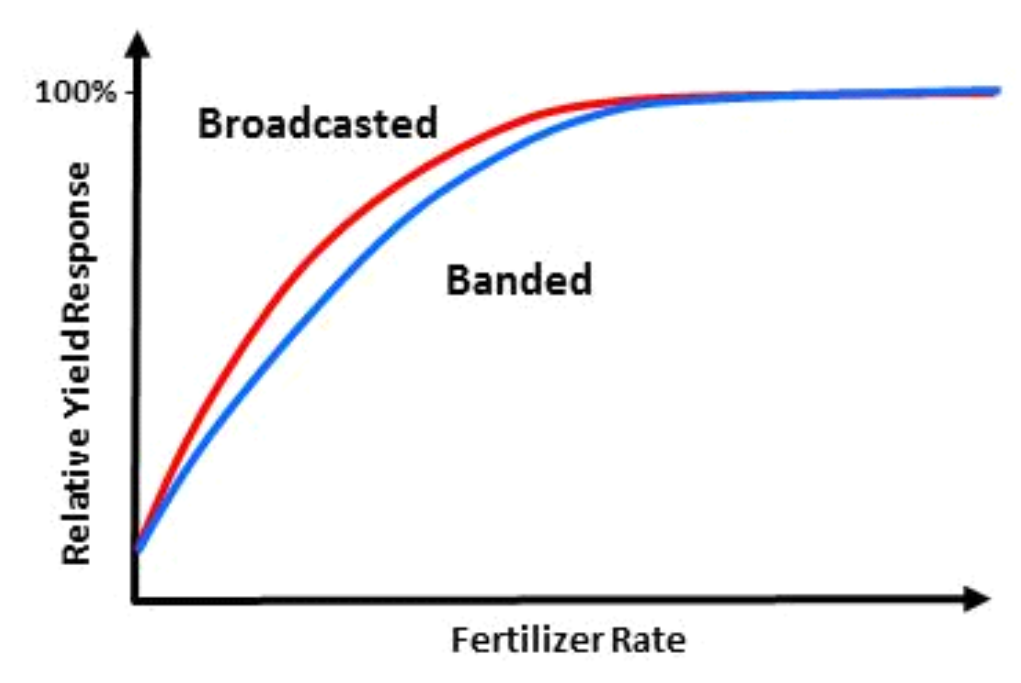⇦ Back to Fertilizer Lime Amendment Technology and Use Home
¶ Introduction
“Is banding or broadcasting better?”, is a question that is often hotly debated by agronomists. The truth is that neither method is necessarily better - just different. The comparative difference in yield response can change, depending on specific crop and field conditions.
This Crop File is a quick overview of phosphorus placement methods. Four common relationships show up when comparing the yield response due to different placement methods that have been collected from a wide variety of research results. The graphs in this Crop File are used only to show the relative yield response as a percent of maximum yield. They are not intended to predict actual yields for a specific method or specific phosphate fertilizer rate.
¶ 1. Banded phosphate exceeds broadcast phosphate at low rates, but eventually both methods reach the same yield at high rates

This response is common when the phosphorus soil test is low to medium, when soils have a high phosphorus buffering capacity, and when soils are cold and wet. Rates of banded phosphate seem to be more “efficient” than broadcasted phosphate in this situation, but only up to some maximum fertilizer rate where the advantage seems to disappear.
Recommendations to reduce the broadcast rate by one-half to one-third are justified when the field conditions favor this response. Rates should only be reduced when the soil test levels or fertilizer rates are Crop File relatively low. There is little or no yield advantage for either placement method at the same application rates.
¶ 2. Banded phosphate exceeds broadcast phosphate, but methods do not reach the same yield

This response is often seen when the soil test is low to very low, the broadcast fertilizer is poorly incorporated, and the soil surface is dry.
An example of this condition is non-irrigated winter wheat where tillage is shallow in order to conserve soil moisture. The broadcast phosphate tends to remain in the dry surface soil where root development is limited. This results in little root-to-soil contact and little phosphorus uptake. The banded phosphate uptake is greater because it is placed in moist soil where more roots have developed..
This may also occur in higher testing soils when rapid early growth is essential for reaching the full yield potential. Cold and wet soils, very early planting, poorly drained soils, soil compaction or other conditions may delay root development. Banding phosphorus fertilizer close to the seedling root system often leads to a large early-season growth response, which may result in higher yields.
This response is common in vegetable crops (like potatoes) which typically have small root systems that contact a limited soil volume. As a result, these crops seem to utilize soil phosphorus rather poorly during early growth. A concentrated band of phosphate placed near the root system is often essential for optimum yields and maturity.
This response frequently occurs in soils with a high phosphorus buffering potential, especially when the soil test is low and the fertilizer is applied well in advance of planting. Calcareous soils, acidic soils, and high clay soils often have high buffering capacity. This implies that phosphorus ions are not easily released for root uptake.
The phosphorus in the applied fertilizer can adsorb onto the surface of fine carbonate (lime) crystals found in calcareous soils. Phosphorus will adsorb onto the surface of aluminum and iron minerals found in acidic soils. The phosphorus remains available for root uptake for a time on these surfaces, but gradually forms insoluble phosphates as time progresses. Phosphate ions can also be held tightly on clay surfaces of soils with high clay soils (over 70%) and not easily released to the soil solution for root uptake.
¶ 3. Banded phosphate equals broadcast phosphate.

The “equal” response typically occurs when soil phosphorus levels are high to very high, when broadcast phosphate is incorporated well by tillage, and with adequate soil moisture. The root-to-fertilizer contact is good in both cases, so there is no placement advantage.
Placement differences can small or non-existent with certain warm-season crops. The soil reactions that make phosphorus available to the seedling root system become more rapid as the soil temperature increases. Thus the young roots of warm-season crops may have relatively more soil phosphorus available to their root surfaces than do cool-season crops planted in colder soils where these reactions are slower.
¶ 4. Broadcast phosphate exceeds banded phosphate

This is may not be a common response, but has been noted in no-till situations. Typical conditions for this response are soils with low phosphorus buffering capacity, zero-tillage, and a humid climate or under irrigation.
The zero-tillage system results in a heavy residue cover, so the soil temperature is highest at the soil surface, but drops quickly with depth. Root density is highest in the surface, under the residue cover where soil temperatures are warmest, and also where the broadcast phosphate is available for uptake. The banded phosphorus is located deeper in the soil where temperatures are cooler, where roots are slower to develop, and where root density and phosphorus uptake are limited.
¶ The answer - “It depends.”
The question “Is banding or broadcasting better?” is not a simple either/or answer. Specific field conditions, like soil test, weather, soil type, crop, etc., will affect the expected response to a given placement method Producers must consider the equipment cost, fertilizer cost, time available for application, and his own unique crop management strategy. In many cases, some combinations of both methods will prove most profitable.
¶ References
Fixen, P.E. and D.F. Leikam. 1988. An overview of phosphorus placement. Proceedings of Great Plains Soil Fertility Conf. Denver, Colo. Dec. 8-9, 1988. pp. 37-51